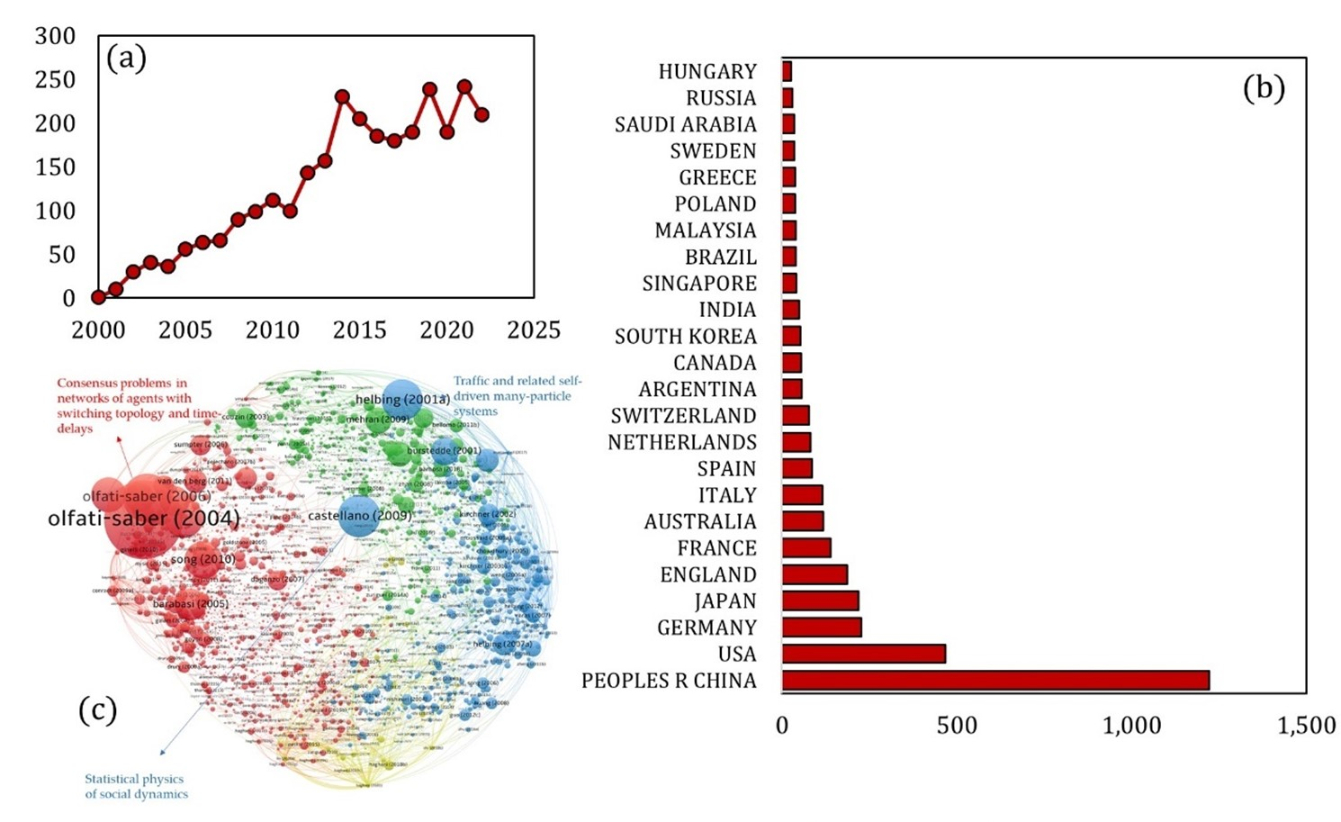Revisiting the paper ”Simulating dynamical features of escape panic”: What have we learnt since then?
DOI:
https://doi.org/10.17815/CD.2024.168Keywords:
Social Force Model, Pedestrian Dynamics, Crowd Dynamics, Evacuation SimulationAbstract
The paper "Simulating dynamical features of escape panic" by Helbing, Farkas, and Vicsek, published over two decades ago in Nature, has left an indelible mark on the field of crowd dynamics.
With nearly 3,000 citations to date, according to the Web of Science records, this influential work has significantly shaped the field. This analysis investigates the overall influence of this paper through various indicators, documenting its reach across multiple research areas. The intellectual foundation of the paper is traced, examining the references cited and uncovering some misalignments between certain assertions and the citations meant to support them. The terminological impact is also explored, showing how the paper invigorated the use of terms like "panic" and "herding". Moreover, the alignment of some key assumptions of the paper with empirical evidence that has emerged since its publication is investigated, revealing discrepancies in key assertions about panic behaviour. It is also determined that the numerical observations of the paper have significantly influenced the field by introducing concepts such as the "faster-is-slower" phenomenon, on which empirical research has since produced mixed evidence rather than irrefutable support.
While the paper remains a key pillar in crowd dynamics, we advocate for a new course for the field that could facilitate a paradigm shift in conceptualising crowd behavior, particularly one that reconsiders some terminologies and key behavioral concepts adopted in the paper, rather than treating them as proven.
References
Helbing, D., Farkas, I., Vicsek, T.: Simulating dynamical features of escape panic. Nature 407(6803), 487-490 (2000)
Helbing, D., Molnar, P.: Social force model for pedestrian dynamics. Physical review E 51(5), 4282 (1995)
Helbing, D.: Traffic and related self-driven many-particle systems. Reviews of modern physics 73(4), 1067 (2001)
Burstedde, C., Klauck, K., Schadschneider, A., Zittartz, J.: Simulation of pedestrian dynamics using a two-dimensional cellular automaton. Physica A: Statistical Mechanics and its Applications 295(3-4), 507-525 (2001)
Keating, J.P.: The myth of panic. Fire Journal 76(3), 57-61 (1982)
Johnson, N.R.: Panic at “the who concert stampede”: an empirical assessment. Social Problems 34(4), 362-373 (1987)
Quarantelli, E.L.: The behavior of panic participants. Sociology and Social Research 41, 187-194 (1957)
Quarantelli, E.L.: Panic, sociology of (2001)
Feliciani, C., Corbetta, A., Haghani, M., Nishinari, K.: How crowd accidents are reported in the media: Lexical and sentiment analyses. arXiv preprint arXiv:2309.14633 (2023)
Drury, J., Cocking, C., Reicher, S., Burton, A., Schofield, D., Hardwick, A., Graham, D., Langston, P.: Cooperation versus competition in a mass emergency evacuation: A new laboratory simulation and a new theoretical model. Behavior research methods 41(3), 957-970 (2009)
Bartolucci, A., Casareale, C., Drury, J.: Cooperative and competitive behaviour among passengers during the costa concordia disaster. Safety science 134, 105055 (2021)
Uesten, E., Schumann, J., Sieben, A.: Exploring the dynamic relationship between pushing behavior and crowd dynamics. Collective Dynamics 8, 1-29 (2023)
Haghani, M., Cristiani, E., Bode, N.W., Boltes, M., Corbetta, A.: Panic, irrationality, and herding: three ambiguous terms in crowd dynamics research. Journal of advanced transportation 2019 (2019)
Low, D.J.: Following the crowd. Nature 407(6803), 465-466 (2000)
Kinateder, M., Comunale, B., Warren, W.H.: Exit choice in an emergency evacuation scenario is influenced by exit familiarity and neighbor behavior. Safety science 106, 170-175 (2018)
Haghani, M., Sarvi, M., Shahhoseini, Z.: When ‘push’does not come to ‘shove’: Revisiting ‘faster is slower’in collective egress of human crowds. Transportation research part A: policy and practice 122, 51-69 (2019)
Zuriguel, I., Echeverría, I., Maza, D., Hidalgo, R.C., Martín-Gómez, C., Garcimartín, A.: Contact forces and dynamics of pedestrians evacuating a room: the column effect. Safety science 121, 394-402 (2020)
Haghani, M.: Empirical methods in pedestrian, crowd and evacuation dynamics: Part i. experimental methods and emerging topics. Safety science 129, 104743 (2020)
Pastor, J.M., Garcimartín, A., Gago, P.A., Peralta, J.P., Martín-Gómez, C., Ferrer, L.M., Maza, D., Parisi, D.R., Pugnaloni, L.A., Zuriguel, I.: Experimental proof of faster-is-slower in systems of frictional particles flowing through constrictions. Physical Review E 92(6), 062817 (2015)
Haghani, M., Sarvi, M.: Crowd model calibration at strategic, tactical, and operational levels: Full-spectrum sensitivity analyses show bottleneck parameters are most critical, followed by exit-choice-changing parameters. Transportation Letters pp. 1-28 (2023)
Zhao, Y., Lu, T., Su, W., Wu, P., Fu, L., Li, M.: Quantitative measurement of social repulsive force in pedestrian movements based on physiological responses. Transportation research part B: methodological 130, 1-20 (2019)

Downloads
Published
How to Cite
Issue
Section
Categories
License
Copyright (c) 2024 Enrico Ronchi, Milad Haghani

This work is licensed under a Creative Commons Attribution 4.0 International License.
Authors contributing to Collective Dynamics agree to publish their articles under the Creative Commons Attribution 4.0 license.
This license allows:
Share — copy and redistribute the material in any medium or format
Adapt — remix, transform, and build upon the material
for any purpose, even commercially.
The licensor cannot revoke these freedoms as long as you follow the license terms.
Authors retain copyright of their work. They are permitted and encouraged to post items submitted to Collective Dynamics on personal or institutional websites and repositories, prior to and after publication (while providing the bibliographic details of that publication).








